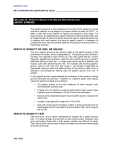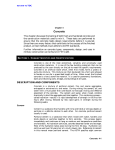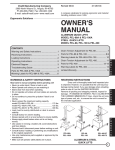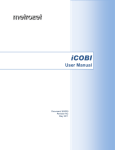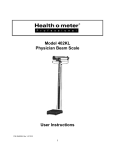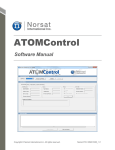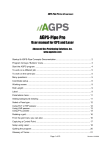Download FM 5-472, Change 2, 1 July 2001
Transcript
FM 5-472 C2 Change 2 Headquarters Department of the Army Washington, DC, 1 July 2001 Materials Testing 1. Change FM 5-472, 27 October 1999, as follows: Remove Old Pages Insert New Pages 2-55 through 2-58 2-83 and 2-84 2-103 and 2-104 4-21 through 4-24 4-29 and 4-31 A-1 2-55 through 2-58 2-83 and 2-84 2-103 and 2-104 4-21 through 4-24 4-29 through 4-31 A-1 2. A bar ( ) marks new or changed material. 3. File this transmittal sheet in front of the publication. DISTRIBUTION RESTRICTION: Approved for public release; distribution is unlimited. By Order of the Secretary of the Army: ERIC K. SHINSEKI General, United States Army Chief of Staff Official: JOEL B. HUDSON Administrative Assstant to the Secretary of the Army 0119105 DISTRIBUTION: Active Army, Army National Guard, and US Army Reserve: To be distributed in accordance with the initial distribution number 110133, requirements for FM 5-472. FM 5-472/NAVFAC MO 330/AFJMAN 32-1221(I) OVEN-DRY METHOD (ASTM D 2216-90) The most accurate method of determining moisture content is the oven-dry method. This method uses an oven with a temperature or thermostatic control. For expedient determinations, soils are sometimes dried in a frying pan or container heated by an external source, either a stove or an exhaust manifold. However, heating most soils to excessive temperatures results in chemical changes that may lead to errors in moisture-content results. Hence, drying soils by an uncontrolled heat source is usually less accurate than drying them in a thermostatically controlled oven. PURPOSE Perform this test to determine the moisture content of a soil sample to within a desired percentage. EQUIPMENT The following items are necessary for this test method: • A laboratory oven. • Heat-resistant gloves. • A calculator. • Moisture-determination tares. • A grease pencil. • A balance scale sensitive to 0.01 gram. • DD Form 1205. • A pencil. STEPS Perform the following steps to determine the moisture content: Step 1. Record all identifying information of the sample in blocks 1 through 5 of DD Form 1205 (see Figure 2-32, page 2-56). Step 2. Label and weigh the clean, dry moisture-determination tares, and record the weights on the form as the weight of the tare (line D). Step 3. Obtain the required soil sample. Place it in the tare and cover it with the lid. • When conducting this test as part of another test method, use the specimen mass stated in that test method. • When conducting this test with no minimum specimen mass provided, use the values provided in Table 2-5, page 2-57, depending on the degree of accuracy of the reported water content. Step 4. Weigh the soil sample and the tare to the nearest 0.01 gram. Record the weight on the form as the weight of the tare and the wet soil (line A). Step 5. Oven-dry the sample, with the moisture-determination tare lid removed, at 110°C ± 5° until the sample weight becomes constant. Oven-drying Soils 2-55 C2, FM 5-472/NAVFAC MO 330/AFJMAN 32-1221(I) LE P M SA Figure 2-32. Sample DD Form 1205 2-56 Soils C2, FM 5-472/NAVFAC MO 330/AFJMAN 32-1221(I) Table 2-5. Recommended minimum test specimen for reporting water content Maximum Particle Size (100% Passing) Standard Sieve Size 2.0 mm or less 4.75 mm Minimum Moist Mass for Reporting to ± 0.1% Minimum Moist Mass for Reporting to ± 1% No. 10 20.0 g 20 g* No. 4 100.0 g 20 g* 9.50 mm 3/8 in 500.0 g 50 g 19.00 mm 3/4 in 2.5 kg 250 g 37.50 mm 1 1/2 in 10.0 kg 1 kg 75.00 mm 3 in 50.0 kg 5 kg * To be representative, not less than 20 grams shall be used. time will vary depending on the type of soil, the size of the sample, and other factors. For routine water-content determination, oven-dry a sample consisting of clean sands and gravel for a minimum of 4 hours. For most other soils, a minimum drying time of 16 hours is adequate. Step 6. Remove the sample from the oven and replace the moisturedetermination tare lid. Allow the sample to cool until the tare can be handled comfortably with bare hands. Step 7. Weigh the dried soil sample and the tare. Record the weight as the weight of the tare and dry soil (line B). Step 8. Determine the weight of the water (Ww) by subtracting the weight of the tare and dry soil (line B) from the weight of the tare and wet soil (line a). Record the weight on the form (line C). Step 9. Determine the weight of the dry soil (Ws) by subtracting the weight of the tare (line D) from the weight of the tare and dry soil (line B). Record the weight on the form (line E). Step 10. Determine the water content (w), in percent, and record it using the following formula: WW w = -------- × 100 WS When determining the average water content, the individual tests must be within ± 1 percent. Any individual tests that do not meet this requirement will not be used (see Figure 2-32). If none of the individual tests meet this requirement, then additional testing is required. CALCIUM-CARBIDE-GAS PRESSURE METHOD (AASHTO T 217-1986) CAUTION The chemical reaction of calcium carbide with water produces acetylene gas which is extremely flammable. Exercise extreme caution to avoid open flame when releasing the gas from the speedy moisture tester. Perform the test in a well-ventilated area, as asphyxiation could occur if performed in a confined area. Soils 2-57 C2, FM 5-472/NAVFAC MO 330/AFJMAN 32-1221(I) Use the calcium-carbide-gas pressure method to determine the moisture content of a soil sample using the 26-gram speedy moisture tester to within ± 0.5 percent. If another tester is to be used, consult the user’s manual for the tester before conducting the moisture-content determination. PURPOSE Perform this test to determine the moisture content of a soil sample to within ± 0.5 percent. EQUIPMENT Use the following items for the calcium-carbide-gas pressure test: • A calcium-carbide-pressure (speedy) moisture tester to hold a 26-gram soil specimen. • A balance (readable to 0.1 gram). • Two 1 1/4-inch steel balls. • A cleaning brush and cloth. • A scoop (for measuring calcium-carbide reagent). • Calcium-carbide reagent. STEPS Perform the following steps to determine the soil’s moisture content: Step 1. Weigh the soil sample to be tested, ensuring that it weighs exactly 26 grams. Place the soil sample in the tester’s body and add the two 1 1/4-inch steel balls. Step 2. Place three scoops (about 24 grams) of calcium carbide into the cap of the tester and, with the pressure vessel in a horizontal position, insert the cap into the pressure vessel. Seal the unit by tightening the clamp, taking care that no carbide comes in contact with the soil until a complete seal is achieved. Step 3. Raise the moisture tester to a vertical position so that the reagent in the cap will fall into the pressure vessel. Step 4. Shake the instrument vigorously in a rotating motion so that all lumps are broken up to permit the calcium carbide to react with all available free moisture. Shake the instrument in a rotating motion so that the steel balls will not damage the instrument or cause soil particles to become embedded in the orifice leading to the pressure diaphragm. Continue shaking at least 1 minute for granular soils and up to 3 minutes for other soils to permit complete reaction between the calcium carbide and the free moisture. Allow time for the dissipation of the heat generated by the chemical reaction. Step 5. Hold the instrument in a horizontal position at eye level. Read the dial when the needle stops moving. Record the dial reading as the percent of moisture by wet mass. Step 6. Point the cap of the instrument away from the operator and release the gas pressure slowly. Empty the pressure vessel and examine the material for lumps. If the sample is not completely pulverized, repeat the test using a new 2-58 Soils C2, FM 5-472/NAVFAC MO 330/AFJMAN 32-1221(I) stem. For the Type 151H hydrometer, the composite correction is the difference between this reading and 1. For the Type 152H hydrometer, the composite correction is the difference between the reading and 0. e. Record the composite correction in block 11 of the form (Figure 2-43, page 2-81). f. Remove the hydrometer from the dispersing-fluid cylinder and place it in a second cylinder filled with distilled water. NOTE: From this point forward, all hydrometer readings will be taken from the top of the meniscus. Step 4. Perform the hydrometer test. a. Record all identifying information for the sample, dispersing agent, quantity used, and composite correction on the form. b. Obtain the decimal fines from the original soil sample from DD Form 1206. Record it on DD Form 1794 (block 12). c. Obtain the specific gravity of solids (Gs) of the soil sample from DD Form 1208. Record it on DD Form 1794 (block 13). d. Empty and thoroughly rinse the graduated cylinder containing the dispersing solution from step 3. e. Transfer the soaked sample to a dispersion cup, using distilled water to wash any residue from the dish into the cup. Add distilled water to the cup until the water surface is 3 inches below the top of the cup. Place the cup in the dispersing machine and mix silts and sands for 5 minutes, lowplasticity clay for 7 minutes, and high-plasticity clay for 9 minutes. f. Transfer the mixed solution to the clean 1,000-milliliter graduated cylinder, using distilled water to wash any residue from the cup into the cylinder. Add distilled water until the 1,000-milliliter volume mark is reached. g. Place the rubber cap over the open end of the cylinder. Turn the cylinder upside down and back for a period of 1 minute to complete the agitation of the slurry. NOTE: The number of turns during this minute should be about 60, counting the turn upside down and back as two turns. If any soil remains at the bottom of the cylinder during the first few turns, it should be loosened by vigorous shaking of the cylinder while it is in the inverted position. h. After shaking the cylinder for 1 minute, place it on a level and sturdy surface where it will not be disturbed. Remove the cap and start the timer. Remove any foam that has formed during agitation by lightly touching it with a bar of soap. i. Immerse the hydrometer slowly into the liquid 20 to 25 seconds before each reading. Take the actual hydrometer reading (R1) at 1 and 2 minutes of elapsed time. As soon as the 1- and 2-minute readings are taken, carefully remove the hydrometer and place it in the second cylinder of pure distilled water using a spinning motion. Record the reading on the form (block 16). Soils 2-83 C2, FM 5-472/NAVFAC MO 330/AFJMAN 32-1221(I) j. Place a thermometer in the solution. Record the temperature reading, in centigrade, to the nearest whole degree. Record on the form (block 18). NOTE: It is extremely important to obtain accurate temperature readings. The soil hydrometer is calibrated at 20°C. Variations in temperature from this standard temperature produces inaccuracies in the actual hydrometer readings. These inaccuracies will be compensated for later during the computations. k. Repeat steps 4i and 4j for the remainder of the required readings. Take readings at the following intervals: 5, 15, and 30 minutes and 1, 2, 4, and 24 hours. After each reading, remove the hydrometer, place it in the hydrometer of distilled water, and obtain the temperature reading. Record the information on the form for each reading. Step 5. Determine the dry weight of the sample by carefully washing all of the sample into a preweighed pudding pan or dish (block 24). Oven-dry the sample, allow it to cool, and determine and record the weight of the sample and the pan or dish (block 23). Step 6. Determine the weight of the dry soil by subtracting the weight of the pan from the weight of the pan and dry soil. Record this information on the form as the weight of the oven-dried soil (Ws) used for hydrometer testing (block 25). Step 7. Compute the results on DD Form 1794 (see Figure 2-43, page 2-81). a. Column 17. Obtain the corrected reading (R) by adding the actual hydrometer reading (column 16, R1) and the composite correction (block 11) and record the sum on the form. R = R1 + composite correction b. Column 19. Obtain the temperature versus specific gravity constant (K) from Table 2-10. Record it on the form. NOTE: Although typical specific-gravity values are listed in Table 210, there may be cases when a soil type falls above or below this range of values. In these situations the value of K must be computed using the following formula: K = where— 30η η --------------Gs – 1 η = coefficient of viscosity of the liquid (water) in poises (varies with changes in temperature) Gs = Specific gravity of solids for the material being tested c. Column 20. Obtain the effective depth (L) for each corrected reading (column 17) by using Table 2-11, page 2-86, and record on the form. 2-84 Soils FM 5-472/NAVFAC MO 330/AFJMAN 32-1221(I) EQUIPMENT Perform the compaction test using the following items: • Cylinder molds (use one of the following molds, depending on the soil sample being processed): — Proctor mold; 4-inch (4.0-inch inside diameter and 4.584-inch inside height having an internal volume of 0.0333 cubic foot), having an extension collar (2.375 inches high) and a detachable metal baseplate. — CBR mold; 6-inch (6-inch inside diameter and 7-inch inside height), having an extension collar (2 inches high) and detachable metal baseplate. The mold should also have a metal spacer disk (5.94-inch inside diameter and 2.416 inches thick) for use as a false bottom in the mold during testing. When the spacer disk is in place in the bottom of the mold, the internal volume of the mold (excluding extension collar) shall be 0.075 cubic foot. • A compacting hammer or tamper. A sliding-weight type compacting tamper, having a 2-inch-diameter steel striking face, a 10-pound mass, and an 18-inch fall. • A No. 4 sieve. • A 3/8-inch sieve. • A 3/4-inch sieve. • A balance scale sensitive to 0.01 gram. • A balance scale sensitive to 1.0 gram. • Moisture tares. • A soils oven. • Filter paper. • A large spoon. • A large knife. • A steel straightedge. • A calculator. • DD Form 1210. • DD Form 1211. The amount of material (field sample) required for the compaction test depends on the test procedure being used and the field sample ’s moisture content. The following are guidelines for the amount of soil required for the test procedures: • Procedures A and B: Use about 35 pounds of dry soil or at least 50 pounds of moist soil. Soils 2-103 C2, FM 5-472/NAVFAC MO 330/AFJMAN 32-1221(I) • Procedure C: Use about 75 pounds of dry soil or at least 100 pounds of moist soil. STEPS Perform the following steps for the compaction test: Step 1. Determine the test procedure to be used. • If the CBR design and tests are to be developed for this project, do not use this method. See Section IX for procedures to be used for CBR. • If CBR is not a factor, determine the test procedure by evaluating the gradation criteria of the procedures listed above (A, B, or C) with column 17 (percent retained) on DD Form 1206. Step 2. Prepare the soil sample. a. Dry the sample until it can be easily crumbled under a trowel. Drying may be done by air-drying or by using a drying apparatus, provided the temperature of the sample does not exceed 60°C. b. Break up the sample thoroughly, but not in such a manner as to reduce the size of the individual particles. c. Sieve the sample over a No. 4 (procedure A), 3/8-inch (procedure B), or 3/4-inch sieve (procedure C). When preparing the material by passing it over the 3/4-inch sieve for compaction in the 6-inch mold, break up aggregates sufficiently to at least pass the 3/8-inch sieve. This facilitates the distribution of water throughout the soil in later mixing. d. Separate from the sample 5 equal portions representing each point desired on the compaction curve. The size of each sample for one mold is about 2,700 grams for procedures A and B or 6,800 grams for procedure C. Retain all excess soil sample. Step 3. Adjust the water content. NOTE: The water-content adjustments in this step are designed to provide approximations of the OMC. In no way should these approximations be used for or be interpreted as the actual moisture content. Exact moisture determinations will be conducted in a later step. a. Establish the assumed or approximate OMC. (1) Place exactly 100 grams of the excess soil sample in a dish. (2) Add 5 milliliters of water to the sample and mix thoroughly. The approximate OMC is typically achieved so that when the soil is squeezed in the palm, it will adhere together on its own but it will break cleanly into two separate pieces without either piece shattering when bent. Usually this will be slightly less than the PL. (3) Add small amounts of water (in milliliters), remembering to record the amounts added, until the approximate OMC is achieved. Do not confuse the approximate OMC with the actual moisture content of this soil, which will be determined in a later step. For purposes of conducting the test method, the approximate OMC will be the amount 2-104 Soils C2, FM 5-472/NAVFAC MO 330/AFJMAN 32-1221(I) • A tamping rod (5/8 inch in diameter and 24 inches long with a rounded end). • A sample of plastic (fresh) concrete. • Water. • Oil. • Rags. • A pail. • A mixing pan (from the concrete test set). • A kitchen scoop. • Paper. • A pencil. • A rubber mallet. STEPS There are many different air-entrainment meters currently fielded and replacements of old equipment may not be the same. For this reason, it is recommended that the steps outlined in the manufacturer’s user’s manual be followed. SECTION IV. FLEXURAL-STRENGTH TEST (MODULUS OF RUPTURE) The flexural strength of hardened concrete is measured by using a simple concrete beam and third-point loading mechanism. The flexural strength is determined by calculating measured breaks of the beam and is expressed as a modulus of rupture in psi. TEST BEAMS Beam forms for casting test beams from fresh concrete are available in many sizes. The most commonly used size is 6 x 6 x 21 inches. Although equipment for obtaining sawed specimens may not be available, the test may be performed on beams sawed from existing concrete structures for evaluation purposes. FORMING THE BEAMS (ASTM C 192-90A) Assemble a standard 6- x 6- x 21-inch concrete-beam mold and lightly oil the inside. Fill the mold with two layers of concrete from the production batches, each about 3 inches deep. Consolidate each layer by rodding, using one stroke per 2 square inches (63 per layer), evenly distributed over the layer’s surface. Tap the sides lightly 10 to 15 times with a rubber mallet to close the voids left by rodding. Lightly spade the concrete along the mold’s sides with a trowel to help remove surface voids. When rodding the second layer, penetrate the first layer about 1/2 inch. Strike off the top surface with a straightedge, and finish it with a wood or magnesium float. Concrete 4-21 FM 5-472/NAVFAC MO 330/AFJMAN 32-1221(I) TAKING THE SPECIMENS Take test specimens at least once for each 100 cubic yards or fraction thereof, for each class of concrete placed in any one day, or as directed in the project specifications. Make at least three specimens for each test age and mixture design being evaluated in the lab. Additional specimens may be made for future testing. Test ages are normally 14 and 28 days for flexural-strength tests. For testing field-placed concrete, a minimum of two specimens for each test age is required. CURING THE BEAMS Place a suitable identifying label on the finished surface of the specimens. Cover the entire specimens—still in the mold—with a double thickness of wet burlap. Ensure that the specimens remain on site and are undisturbed for an initial curing period (the first 16 to 48 hours after molding). After this curing period, move them to the testing laboratory and remove them from the molds for further curing. The most satisfactory curing range for concrete is 68° to 86°F, with 73.4°F being the most favorable temperature. Moist-cure the beams in saturated lime water, totally submerged in a wet-tank humidity room, or keep them wet until they are tested. FLEXURAL-STRENGTH TEST (ASTM C 78-94) Perform this test to determine the flexural strength (modulus of rupture) of the test specimen to + 10 psi. Record the specimen identification, modulus of rupture, any defects noted, and specimen’s age. EQUIPMENT Use the following items to perform this test in a laboratory environment: • The flexural-strength test apparatus. • A concrete beam, 6 x 6 x 21 inches. • A measuring tape. • A stopwatch. • Pens. • Pencils. • Paper. • Safety goggles. • A proving-ring with proving-ring calibration and constant. • Specimen identification. • A calculator. STEPS Perform the following steps to determine the flexural strength. Wear safety goggles throughout this test. Step 1. Assemble the test apparatus and check for functional operation (see Figure 4-5). 4-22 Concrete C2, FM 5-472/NAVFAC MO 330/AFJMAN 32-1221(I) Apply load here Loading Steel rod Specimen Steel ball (d) in Steel rod Steel ball Length of span Figure 4-5. Apparatus for flexural-strength test Step 2. Measure the length of span and record the measurement on a piece of paper. The length of span is determined by measuring the distance from center to center of the two loading points (or supports) on the base of the apparatus (see Figure 4-5). The normal length of specimen is 21 inches and the normal length of span is 18 inches. Step 3. Place the specimen in the tester and bring the loading surface into contact with the test specimen (see Figure 4-5). Step 4. Zero the gauge. Some apparatus are equipped with a hydraulic pump and corresponding gauge while others are equipped with a loading jack and proving ring. Step 5. Apply a load at a continuous rate that constantly increases the extreme fiber stress between 125 and 175 psi per minute. This is an approximate load of 1,500 to 2,100 pounds per minute. Step 6. Obtain the total load, in pounds, at the time of specimen failure, and record the weight on the paper provided. On machines equipped with hydraulics, take the reading directly from the gauge. For machines equipped with a proving ring, this reading is the product of the dial-gauge reading and the proving-ring constant. Step 7. Determine and record the width and depth of the specimen, in inches, at the point of failure (normally 6 x 6 inches). Step 8. Determine the point of failure in the specimen, and calculate the modulus of rupture. If the specimen fails outside the middle third of the span length by more than 5 percent of the total span length, then the specimen is Concrete 4-23 C2, FM 5-472/NAVFAC MO 330/AFJMAN 32-1221(I) considered unusable and should be discarded (not more than 0.9 inches for an 18-inch span (18 x 0.05 = 0.9). a. Use the following formula to calculate the modulus of rupture if the specimen fails within the middle third of the span length: where— P×L R = --------------b × d2 R = modulus of rupture, in psi P = applied load, in pounds L = length of span, in inches b = width of specimen at failure point, in inches d = depth of specimen at failure point, in inches b. Use the following formula to calculate the modulus of rupture if the specimen fails outside the middle third of the length of span by not more than 5 percent of the span length: 3P × a R = ---------------b × d2 where— R = modulus of rupture, in psi P = applied load, in pounds b = width of specimen at failure point, in inches d = depth of specimen at failure point, in inches a = distance between the failure point and the nearest support, measured along the centerline of the bottom of the specimen, in inches Step 9. Record the following information about the test (some information may be unavailable at the time of the test): 4-24 Concrete • Specimen’s identification number. • Average width to the nearest 0.05 inch. • Average depth to the nearest 0.05 inch. • Span length, in inches. • Maximum applied load, in pounds. • Modulus of rupture, to the nearest 10 psi. • Curing history (how the specimen was cured) and apparent moisture content of the specimen at the time of the test. • Any defects noted in the specimen. • The age of the specimen. FM 5-472/NAVFAC MO 330/AFJMAN 32-1221(I) • A ruler accurate to 0.01 inch. • Calipers with at least a 6-inch opening. • Paper. • Pencils. • Safety goggles and protective apron. • A face shield. • Oil. • Rags. • A calculator. • A concrete compression tester with a 250,000-pound capacity. • A hammer (ball peen or carpenter’s). STEPS Perform the following steps to determine the concrete cylinder’s compressive strength: Step 1. Prepare the concrete cylinder. NOTE: If rubber-filled metal is used, go to step 1j. a. Melt the capping compound in the melting pot. Ensure that you melt enough compound to make several caps. b. Clean and lightly oil the baseplate of the capping apparatus. c. Set the baseplate into the capping-apparatus stand. d. Pour a small amount of the heated (liquid) capping compound into the baseplate. e. Position the cylinder at midheight against the backrest of the capping apparatus. Slowly lower the cylinder into the baseplate while keeping the cylinder flush against the backrest. If the cylinder is not kept flush with the backrest while capping, the caps and the cylinder will not be perpendicular, and a proper break will not occur. f. Remove the cylinder from the capping apparatus once the capping compound has solidified. g. Inspect the cap for uniformity and defects. If you see any defects, remove the cap and recap the cylinder; then return to step 1a. h. Repeat steps 1a through 1g for the uncapped end of the cylinder. i. Determine and record the average diameter of the concrete cylinder. The average diameter is the average of two diameters taken perpendicular to each other at midheight of the cylinder. j. Clean and examine the bearing surface of the steel cap (if used) for nicks, gouges, and warping. Check the rubber inserts for tears, rips, cuts, and gouges. Replace them if they are in poor condition or if the maximum Concrete 4-29 C2, FM 5-472/NAVFAC MO 330/AFJMAN 32-1221(I) number of serviceable uses has been exceeded. Place the steel cap firmly on the cylinder’s ends. Step 2. Prepare the compression tester (see Figure 4-6). a. Clean the tester’s bearing plates (loading surfaces). b. Check the tester for proper operation. c. Set the gauge to zero. Step 3. Place the capped cylinder into the compression tester and center it on the bearing plates. Secure the protective cage around the cylinder. Step 4. Apply the test load at a rate of 20 to 50 psi per second, not to exceed 50 psi per second (50 psi per second is about equivalent to a load [gauge reading] of 1,400 pounds per second). Step 5. Read the gauge and record the load applied at the time of failure. Step 6. Inspect the broken cylinder and record the following information: • Identification number. • Diameter. • Cross-sectional area, in square inches. • Maximum load applied, in pounds. • Compressive strength, calculated to the nearest 10 psi. • Type of break (see Figure 4-7). • Defects in either specimen or caps. • Age of specimen. Step 7. Calculate and record the compressive strength of the cylinder using the following formula: P Compressive strength = --A where— P = load at time of failure, in pounds A = π r2 4-30 Concrete C2, FM 5-472/NAVFAC MO 330/AFJMAN 32-1221(I) Figure 4-6. Compression tester Cone Cone and split Cone and shear Shear Columnar Figure 4-7. Types of fractures Concrete 4-31 C2 Appendix A Metric Conversion Chart This appendix complies with current Army directives which state that the metric system will be incorporated into all new publications. Table A-1 is a conversion chart. Table A-1. Metric conversion chart Metric to English Multiply By English to Metric To Obtain Multiply By To Obtain Length Centimeters 0.0394 Inches Inches 2.54 Centimeters Meters Meters 3.28 Feet Feet 0.0305 Meters 1.094 Yards Yards 0.9144 Meters Kilometers 0.621 Miles (stat) Miles (stat) 1.5609 Kilometers Kilometers 0.540 Miles (naut) Miles (naut) 1.853 Kilometers Millimeters 0.039 Inches Inches 25.40 Millimeters Area Square centimeters 0.1550 Square inches Square inches 6.45 Square centimeters Square meters 10.76 Square feet Square feet 0.0929 Square meters Square meters 1.196 Square yards Square yards 0.836 Square meters 16.39 Cubic centimeters Volume Cubic centimeters 0.610 Cubic inches Cubic inches Cubic meters 35.3 Cubic feet Cubic feet 0.0283 Cubic meters Cubic meters 1.308 Cubic yards Cubic yards 0.765 Cubic meters Milliliters 0.0338 US liq ounces US liq ounces 29.6 Milliliters Liters 1.057 US liq quarts US liq quarts 0.946 Liters Liters 0.264 US liq gallons US liq gallons 3.79 Liters Weight Grams 0.0353 Ounces Ounces 28.4 Grams Kilograms 2.20 Pounds Pounds 0.454 Kilograms Metric tons 1.102 Short tons Short tons 0.907 Metric tons Metric tons 0.984 Long tons Long tons 1.016 Metric tons Subtract 32 and multiply by 0.5556 Celsius Temperature Celsius Add 17.8 and multiply by 1.8 Fahrenheit Fahrenheit Metric Conversion Chart A-1

















